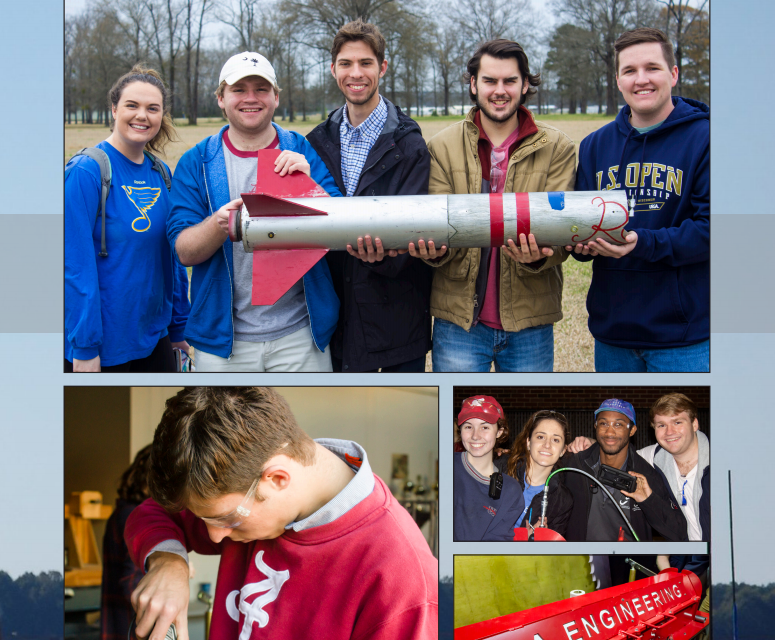STORY BY
ZACHARY STEWART
PHOTOS BY
GREG LIESEN
DESIGN BY
CHRIS JARMON
The University of Alabama is going to space—at least, that’s part of the Project ARES’ mission. ARES, which is an acronym for Alabama Rocket Engineering Systems, is composed of underclassmen students that design and build rockets for competitions and research. It’s also a great opportunity for those interested in STEM subjects to develop their skills with real-world application.
and research. It’s also a great opportunity for those interested in STEM subjects to develop their skills with real-world application.
The club is divided into three teams: liquid propulsion, solid propulsion, and those that handle the business aspects of the program. It’s important to note that membership isn’t restricted to engineering or physics majors; any undergraduate student at UA can join.
Currently, the liquid propulsion team is competing in a three-year competition called The Base 11 Space Challenge that promises $1 million to the first university that can launch a single-stage rocket to 100 kilometers (that’s where suborbital space begins). This is the first year of the competition, so the team’s primary focus is the design and manufacturing of the vehicle and its propulsion system. By the end of 2019, they plan to begin testing.
The solid propulsion team, which competes in the IREC (Intercollegiate Rocket Engineering Competition), is innovating to create designs that will allow for stage separation. For those unfamiliar with rocketry, it means that the vehicle will have multiple  engines, each optimized for a different mass. This team will travel to White Sands, New Mexico to perform an exhibition launch, where they plan to reach 100,000 feet.
engines, each optimized for a different mass. This team will travel to White Sands, New Mexico to perform an exhibition launch, where they plan to reach 100,000 feet.
For Sean Tibbetts, the propulsion leader on the solid propulsion team, the most rewarding aspect of the program is the learning experience and getting to see its resulting product.
“I enjoy the design portion. Project ARES was created to give Aerospace Engineering students something practical, as other departments have clubs like the Eco-Car and the F1 Team,” Tibbetts said. “Before, we could design rockets on paper, but we didn’t know if they would work. Now, we’re seeing a byproduct of our creations, which is really exciting.”
While the results of these projects are incredible, they don’t come without significant challenges. To Tibbetts, this helps to make the experience all the more special.
“Learning to predict problems has been a crucial aspect because rockets are full of problems and you never know what’s going to happen,” he said.
 As one could imagine, the problems that arise are often much more complex than what you’d approach in your first physics class.
As one could imagine, the problems that arise are often much more complex than what you’d approach in your first physics class.
“Many of the assumptions you worked with in engineering class are completely out of the window,” said Chase Trautman, project manager for the liquid propulsion team. “There are many, many factors at play. Classes teach you theory and equations, but if you don’t know how to apply them, then what’s the point?”
Even if a student doesn’t plan to work for NASA or SpaceX in the future, the skills that they learn in the Project ARES are beneficial in a multitude of industries.
“I love rockets, but I also really enjoy building cars,” said Trautman. “There’s a lot of relevant things I’ve learned in this project that would be very applicable in a car company. As long as you’re getting hands-on experience outside the classroom, you can fly across industries. There’s a competitive job market out there — you can’t be that person who just goes to class anymore. Companies are looking for more than that right now.”
Honors College student and MOSAIC Magazine Photographer Greg Liesen agrees that programs like these are beneficial. “ARES gives me the opportunity to work in a team environment, apply what I’ve learned in my classes, and gain a practical knowledge of rocketry which will be instrumental in the workplace environment,” he said.
For many of their launches, the team takes trips to specialized locations where they can test their vehicles unobstructed by air traffic. Last year, the team traveled to New Mexico to do so.
“I went last year because I was head of the sales team and it was a blast – I don’t mean to be making puns,” Trautman said. “We took about a 13 member team that stayed in Las Cruces, New Mexico, and we launched at Spaceport America, which was about an hour away.”
Liesen’s favorite memory from the program was when the team hydro-tested a case for the solid-rocket team. He described that Snowhill Engineering of Ozark, Alabama, “was kind enough to deliver a custom-made hydrostatic test stand, which enabled us to perform the test. This was a serious milestone for us in a very long process.” It’s easy to see why local engineering and manufacturing companies are so supportive of ARES’ work.
It’s student-led organizations like this that prepare students to be successful in the workforce through experiences that can’t be had in a classroom. They are diligently working to take The University of Alabama to the forefront of collegiate rocketry, while creating products that operate at the industry standard.




